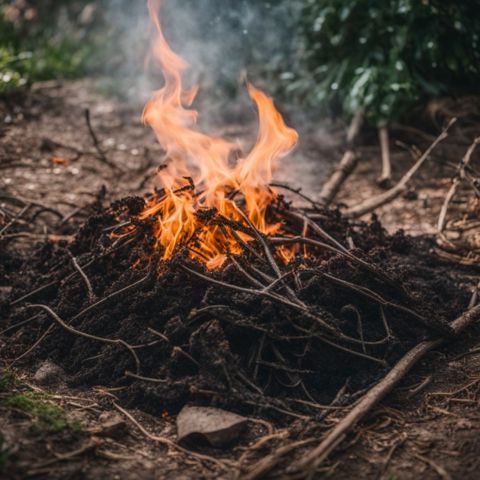
What To Do With Fire Pit Ashes
Dealing with the remains of a backyard fire pit can leave you wondering what to do with fire pit ashes.
Wood ashes from fire pits offer numerous practical applications beyond mere disposal.
This blog post explores creative and eco-friendly ways to utilize fire pit ashes.
Discover a world of possibilities within those gray remnants.
Gathering and Storing Fire Pit Ashes Safely
Allow ashes to cool completely, typically for at least 24 hours, as smoldering embers can pose a risk during this period.

- Use metal containers for storage. Avoid wood, plastic, or cardboard due to reignition risks.
- A fireplace ash bucket with a tight lid prevents spills.
- Scoop ashes carefully, disturbing them minimally to reduce dust.
- Wear protective gloves and masks when handling ashes.
- Store containers away from combustible materials and heat sources.
- Label containers clearly to avoid confusion.
- Keep ashes dry until they are ready for disposal or reuse.
- Consider using a small shovel or trowel for easy transfer.
- Empty containers regularly to prevent overfilling.
- Ensure proper ventilation when handling ashes indoors.
Creative Uses for Fire Pit Ashes
Fire pit ashes can serve as an effective algae remedy for ponds and water features.

While ashes can provide nutrients and adjust soil pH, it's essential to test your soil's pH first, as not all plants benefit from the increased alkalinity.
Ice Melt
Wood ash contains potassium, which has a mild ice-melting effect, though it is generally less effective and slower-acting than commercial de-icers.
Sprinkling fire pit ash on icy surfaces creates a safe, eco-friendly alternative to chemical de-icers.
This inexpensive solution prevents slips while protecting children, pets, and plants from harsh salts.
Fire pit ash provides a cost-effective, environmentally friendly way to melt ice. The potassium content acts as a natural de-icer, eliminating the need for chemical products harmful to vegetation and aquatic life.
Algae Remedy
Wood ash makes an excellent algae remedy for ponds and water features.
While it's theorized that wood ash could suppress algae growth by increasing water alkalinity, its use in ponds or water features is not recommended without consulting a water management specialist due to potential harm to aquatic life.
Spread ash around the perimeter or directly into the water to deter algae formation.
Garden Fertilizer
Wood ash contains valuable minerals like potassium, phosphorus, and calcium.
Avoid using wood ashes around acid-loving plants like azaleas, hydrangeas, and blueberries, as the increased soil alkalinity can harm them.
Mixing ashes into compost piles or directly into garden beds boosts nutrient levels.
While fire pit ashes do supply potassium, which can aid plant growth and fruit production, they should be used cautiously, as excessive use can alter soil chemistry and potentially harm plants.
Incorporating ashes improves soil texture and drainage while raising pH levels for alkaline-craving plants like lilacs and clematis.
It's important to test soil pH before applying wood ashes in gardening.
Due to the potential for significant alterations in soil chemistry, conduct a soil pH test before applying wood ashes and monitor changes carefully.
Cleaning Agent
Wood ashes possess remarkable cleaning properties.
They effectively remove grease, grime, and stains from various surfaces, including glass stovetops and wood stove glass.
While wood ashes can absorb light oil spills on solid surfaces and help neutralize odors, they should be used with caution due to their abrasive nature.
Ashes contain trace minerals beneficial for soap-making. By combining ashes with water and oils, you can create natural lye for homemade soaps.
This process not only utilizes fire pit ashes but also promotes an environmentally conscious lifestyle.
Odor Remover
Continuing the discussion about fire pit ashes, they prove effective as odor removers.
Ashes absorb unpleasant smells, making them ideal for eliminating pet odors or refreshing refrigerators.
Remarkably, wood ashes neutralize skunk spray odors on pets and affected areas. Simply sprinkle ashes over the sprayed surfaces and allow them to absorb the pungent smell before cleaning up.
This natural solution avoids harsh chemical cleaners while leveraging fire pit ashes' odor-absorbing properties.
Using Ashes to Deter Pests
Fire pit ashes deter garden pests and ants. You can sprinkle ashes around plants, to repel insects and animals.

Use fire pit ashes sparingly for pest control to avoid adverse effects on soil health, plant growth, and beneficial insects.
Garden Pests
Wood ashes effectively repel garden pests like slugs, snails, and insects.
Sprinkle ashes around plants, acting as a barrier. Ashes deter pests by causing dehydration and abrasion.
This natural deterrent protects gardens without harsh chemicals.
Utilizing fire pit ashes controls ant infestations near homes. Spread ashes along ant trails, disrupting their movements.
Ants avoid ashes due to their abrasive nature. Ashes eliminate ant colonies harmlessly.
For mouse problems, seal entry points and spread ashes in affected areas. Mice dislike ashes' gritty texture on their paws.
Replenish ashes frequently for effective rodent control. Ashes tackle multiple garden and household pests organically.
Ants
Fire pit ashes act as a natural deterrent against ants. Sprinkle ashes around ant hills and trails to force ants to relocate.
The alkaline nature disrupts their sense of smell, confusing their trail.
Wood ash repels ants and other garden pests, like slugs and snails. Spread a light layer around plants to create a protective barrier. Reapply after rain or watering.
Mice
In addition to deterring ants, another pest that wood ash effectively repels is mice.
Mice dislike the abrasive texture and strong scent of wood ash, making it a natural deterrent.
Spread wood ash around areas where mice frequent, such as baseboards, entry points, and nesting sites.
The ash creates an unpleasant barrier, discouraging mice from entering or residing in those spaces.
Regularly reapplying the ash ensures ongoing protection against these unwanted rodents.
Ashes in Composting and Lawn Care
Wood ash enhances compost piles. Add modest amounts to enrich the compost with minerals like potassium and calcium.
Adding excessive ash to compost can increase its pH balance, potentially impacting the activity of beneficial microbes.
It is important to add ash in moderation.

Sprinkle wood ash on lawns as a natural lime substitute. Test a small area first to ensure the grass tolerates it.
Proper Disposal of Fire Pit Ashes
Proper disposal of fire pit ashes requires caution.
For environmentally friendly disposal, ashes can benefit gardens as fertilizer or soil amendment. Always check local regulations for appropriate disposal methods.
Cooling and Container Guidelines
Proper cooling and containment ensure safe fire pit ash disposal. Cool the ashes completely before transferring them to a metal container.
A tight-fitting lid prevents airborne particles and reignition.
Transport ashes carefully, avoiding spills. Metal shovels simplify moving cooled ashes to disposal areas like compost bins or landfills.
When storing and disposing of wood ash, use sealed containers and follow local environmental regulations to mitigate risks, including those related to heavy metal accumulation in sensitive areas.
Environmentally Friendly Disposal
Wood ashes require cautious disposal. They contain alkaline compounds, which can harm some environments.
For eco-friendly disposal, mix ashes with compost or use them as a soil amendment in moderation.
Avoid dumping large quantities near waterways or vegetation. Spread small amounts evenly in gardens or lawns.
For temporary storage before proper disposal, sealing ashes in a metal container with a lid is recommended to prevent moisture ingress and reduce the risk of accidental dispersal.
Contact your municipality for guidance on proper hazardous waste disposal methods permitted in your area.
Following local regulations ensures minimal environmental impact while responsibly managing fire pit ashes.
Landfill Disposal
Landfill disposal remains an option for fire pit ashes. After cooling completely in a metal container, transport the ashes securely to the landfill.
Confirm local guidelines, as some facilities designate specific areas or procedures for ash disposal.
Many landfills accept cooled wood ashes. However, check the regulations to ensure compliance.
Acidic soils benefit from wood ash application, providing potassium and raising pH levels.
Consider composting ashes or using them as a natural dye mordant before landfill disposal.
FAQs
Can I use fire pit ashes to remove hair dye from the skin?
Yes, the abrasive nature of wood ashes can help exfoliate and remove stubborn hair dye stains from your skin. However, you should consult a medical professional before applying to your skin.
Are fire pit ashes good for my garden?
Fire pit ashes can be beneficial for your garden as they provide nutrients and help adjust soil pH levels. However, be cautious about using too many ashes, as they can affect crop rotations.
Can I use fire pit ashes to dye fabric or hair?
It's not recommended to use wood ashes for dyeing fabrics or hair due to inconsistent results and the potential for damage compared to using products specifically designed for these purposes.
Should I spread fire pit ashes around trees?
It's generally not recommended to spread large amounts of fire pit ashes around trees, as the high alkalinity can harm the tree's roots and potentially lead to nutrient deficiencies.
Conclusion
Knowing what to do with fire pit ashes can offer numerous benefits beyond serving as a heat source.
These versatile byproducts can melt ice, deter pests, and even fertilize gardens.
Proper handling ensures safety, while creative applications maximize their usefulness.
Before implementing any of these uses, it's advisable to conduct further research or consult with a professional in the relevant field (e.g., a master gardener, a composting expert, or an environmental scientist) to ensure that the application of wood ash is appropriate for your specific situation.
Responsible disposal protects the environment while reducing waste. Explore the potential of fire pit ashes today.

